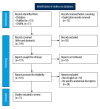Characteristics and Associated Risk Factors of Broad Ligament Hernia: A Systematic Review
- PMID: 39849826
- PMCID: PMC11773988
- DOI: 10.12659/MSM.946710
Characteristics and Associated Risk Factors of Broad Ligament Hernia: A Systematic Review
Abstract
The broad ligament, a double-layered peritoneum attaching the lateral uterus to the pelvic sidewall, plays a vital role in pelvic anatomy. Small bowel herniation through a defect in the broad ligament, known as broad ligament herniation, involving protrusion of viscera through defects in this ligament, is rare but can lead to severe complications. This systematic review aims to evaluate the presentation, diagnosis, management, and factors associated with broad ligament herniation. Following PRISMA guidelines, a systematic search was conducted in PubMed and Cumulative Index to Nursing and Allied Health Literature databases using the terms "broad ligament AND hernia" and "broad ligament AND herniation". Case reports and series with detailed anatomical descriptions were included. Articles not in English or without full-text access were excluded. Extracted data included patient demographics, history of abdominal surgeries, herniated organs, and classification. Results were synthesized to identify patterns and risk factors. A total of 71 articles met the inclusion criteria, with patients predominantly aged 30 to 49 years. A history of abdominal surgery and multiparity were noted to be key risk factors. The small bowel was the most herniated organ (90% of cases). The fenestra type defect accounted for 88.9% of cases, and CT imaging emerged as the preferred diagnostic modality. Detailed surgical and medical histories are crucial in diagnosing broad ligament herniation. Future research should focus on pathogenesis and standardized classification systems to improve management strategies.
Conflict of interest statement
Figures



References
-
- Craig ME, Sudanagunta S, Billow M. StatPearls [Internet] Treasure Island (FL): StatPearls Publishing; 2024. Jan, Anatomy, abdomen and pelvis: Broad ligaments. [Updated 2023 Jul 24] Available from: https://www.ncbi.nlm.nih.gov/books/NBK499943/ - PubMed
-
- Choi PW. Strangulated small bowel obstruction caused by broad ligament hernia: Report of a case and review of literature. Am J Med Case Rep. 2017;5(2):38–40.
-
- Chaudhry SR, Imonugo O, Jozsa F, et al. StatPearls [Internet] Treasure Island (FL): StatPearls Publishing; 2024. Anatomy, abdomen and pelvis: Ligaments. [Updated 2023 Jan 13[ Available from: https://www.ncbi.nlm.nih.gov/books/NBK493215/ - PubMed
-
- Park JH, Kim S, Cho Y. Internal hernia through a defect in the broad ligament of uterus: Laparoscopic management using a self-anchoring barbed suture. J Minim Invasive Surg. 2018;21(3):130–32.
Publication types
MeSH terms
LinkOut - more resources
Full Text Sources
Medical
Miscellaneous

